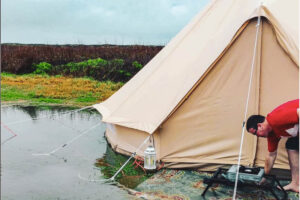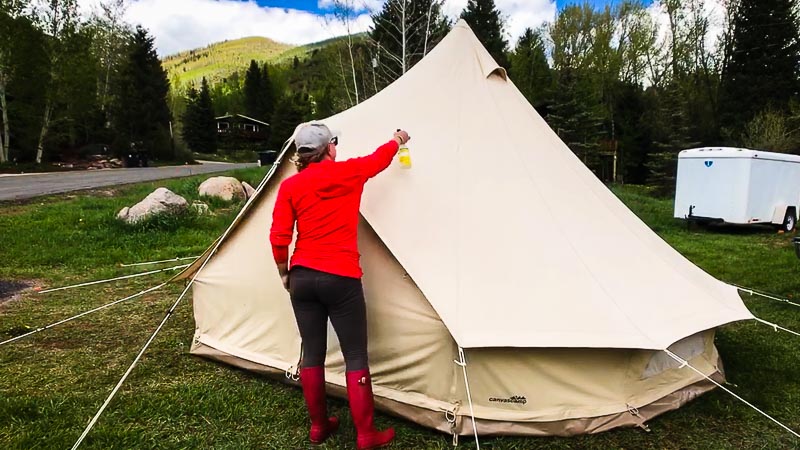How to Waterproof a Canvas Tent
Even though canvas tents can seam water resistant without any waterproofing they can begin to leak after a while or can absorb water causing mildew and mold. Applying waterproofing to a canvas tent is important because over time the weather and consistent use can wear it down.
Seasoning and waterproofing a canvas tent is key in maintaining its water resistance and prolonging its lifespan. Seasoning involves wetting and then drying the canvas to allow the fibers to swell and close any small holes in the fabric. This process can improve the water resistance of the tent and prevent leaks.

How to Season a Canvas Tent
- Set up the tent: Pitch the tent in a dry, sunny area, making sure the seams are properly aligned and the tent is taut.
- Wet the tent: Using a hose or a spray bottle, wet the entire tent, making sure to saturate the canvas thoroughly. Allow the tent to soak for about 15-20 minutes.
- Let the tent dry: Allow the tent to dry completely in the sun. This process can take several hours, depending on the weather conditions.
- Then follow the steps below to properly waterproof a canvas tent
Waterproofing a Canvas Tent
- Clean the tent: Before waterproofing, make sure the tent is clean and dry. Remove any dirt or debris from the tent by sweeping or shaking it out. Use a soft brush or cloth to wipe down any dirty areas, and spot clean any stains using a mild detergent and water. Allow the tent to dry completely.
- Choose a waterproofing treatment: There are several types of waterproofing treatments available, such as waterproofing sprays, waxes, or solutions. Choose a product that is specifically designed for use on canvas fabric and follow the manufacturer’s instructions.
- Apply the waterproofing treatment: Depending on the type of waterproofing product you’ve chosen, the application process may differ. Generally, you’ll need to evenly apply the product to the entire tent using a spray, brush, or sponge. Be sure to apply the product to all seams, corners, and edges, as these areas are most susceptible to leaks.
- Allow the tent to dry: Once the waterproofing treatment is applied, allow the tent to dry completely. This can take several hours or overnight, depending on the weather conditions.
- Test the tent: After the tent is dry, test its water resistance by spraying it with water or using a hose to simulate rainfall. Check for any leaks or areas where water is able to penetrate the fabric.
By following these steps, you can waterproof your canvas tent and ensure it provides a comfortable and dry shelter for your outdoor adventures. Remember to periodically reapply the waterproofing treatment and to properly maintain the tent to prolong its lifespan.

Are Canvas Tents Waterproof?
Canvas tents are often chosen for their durability and natural feel, but are they waterproof? The answer is that it depends on the specific type and quality of the canvas material used. Traditional canvas tents, made from cotton or a cotton-polyester blend, are naturally water-resistant due to the tight weave of the fabric. However, they are not completely waterproof and can begin to leak during prolonged rain or heavy storms. To improve their waterproofing, canvas tents are often treated with wax or a water-resistant coating. Some modern canvas tents are also made with specialized waterproof canvas materials that have higher levels of waterproofing. It’s important to note that even with a high level of waterproofing, canvas tents can still be prone to leaks if the seams or zippers are not properly sealed or if the tent is not pitched correctly. Therefore, it’s important to choose a quality canvas tent and properly maintain it to ensure it stays waterproof and provides a comfortable and dry shelter for outdoor adventures.
Do Canvas Tents Need Waterproofing?
Canvas tents are naturally water-resistant due to the tight weave of the fabric, but they may still require additional waterproofing, especially during prolonged rain or heavy storms. The natural water resistance of canvas can be enhanced by treating the fabric with wax or a water-resistant coating. This treatment can help to improve the tent’s resistance to water and prevent leaks.
However, it’s important to note that over time, the waterproofing on a canvas tent can deteriorate, especially with frequent use, exposure to UV rays, and weather conditions. As a result, it may be necessary to reapply a water-resistant treatment periodically to maintain the tent’s waterproofing.
In addition to applying a waterproofing treatment, it’s also important to ensure that the tent is pitched correctly and that the seams and zippers are properly sealed to prevent water from seeping in. Proper maintenance and care can go a long way in ensuring that your canvas tent remains waterproof and provides a comfortable and dry shelter for your outdoor adventures.
Canvas Tent Maintenance
Proper maintenance of a canvas tent can help to prolong its lifespan, maintain its waterproofing, and reduce the chance of your canvas tent having problems while out camping . Tips on how to maintain a canvas tent:
- Clean the tent after each use: Remove any dirt or debris from the tent by sweeping or shaking it out. Use a soft brush or cloth to wipe down any dirty areas, and spot clean any stains using a mild detergent and water.
- Allow the tent to dry completely: Before storing the tent, make sure it is completely dry to prevent mold and mildew from forming. If possible, hang the tent to dry in a well-ventilated area or in the sun.
- Store the tent properly: When not in use, store the tent in a cool, dry place away from direct sunlight. Avoid storing the tent in a damp or humid area, as this can encourage mold and mildew growth.
- Reapply waterproofing treatment: Over time, the waterproofing treatment on the tent may wear off, especially with frequent use or exposure to the elements. Reapply a water-resistant treatment periodically to maintain the tent’s waterproofing.
- Inspect the tent before each use: Before setting up the tent, inspect it for any tears, holes, or other damage that may compromise its integrity. Repair any damage as soon as possible to prevent it from getting worse.
These tips can help maintain your canvas tent and ensure that it provides a comfortable and reliable shelter for your outdoor adventures.
